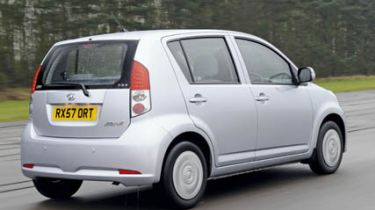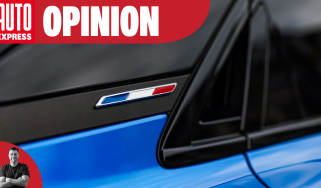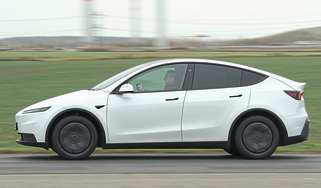Perodua Myvi 1.3 SXi
Latest small car is based on Daihatsu Sirion, but cheaper. Is it a winner?
The Daihatsu Sirion went on sale in the UK in January 2005, so the Perodua’s basic shape is already three years old. Yet in comparison to the firm’s other models, the Myvi appears positively cutting edge. It’s undoubtedly more stylish and better built than any of the company’s other products.
Setting the Myvi apart from the Sirion are unique headlights, reprofiled bumpers and ungainly looking bonnet lines that run down to meet the Perodua badge. Other than that, though, there’s little to distinguish the pair, and it takes a keen eye to tell one from the other.
When lined up alongside the Mazda, the Myvi is clearly very different in concept. The Malaysian car is shorter, both in wheelbase and overall, plus narrower. But it’s 190mm taller – and that means it looks more like a city car, while the 2 has a sportier, European-style supermini shape.
Inside, there’s plenty of leg and headroom in the back of the Perodua. The driving environment is equally spacious, although the high-mounted and upright driving position won’t appeal to all.
The layout is simple and basic, and most drivers will find it easy to get on with. But there is nothing particularly inspiring about the cabin, and the materials and layout don’t look or feel as modern or attractive as those in the Mazda.
Used - available now

2015 Mazda
CX-5
83,500 milesManualDiesel2.2L
Cash £6,595
2017 BMW
1 Series
106,000 milesManualPetrol1.5L
Cash £4,995
2022 Skoda
Karoq
23,000 milesManualPetrol1.0L
Cash £15,995
2022 Volkswagen
ID.3
30,091 milesAutomaticElectric
Cash £13,300The doors are thin, and the Perodua doesn’t give the impression of ‘big car’ solidity that you get in the Mazda. It seems flimsy in comparison, and even though the two cars returned similar meter readings, there’s definitely more road and wind noise in the Myvi at motorway speeds.
Although the Perodua’s suspension isn’t as firm as the Mazda’s, the damping doesn’t feel as composed. It’s easily unsettled on country roads, and the car suffers from considerably more body roll through corners as well.
This extra movement, combined with steering that’s far less accurate, means the Myvi isn’t as much fun and doesn’t inspire confidence in bends. It rides on smaller and narrower tyres,
too, so it reaches the limit of grip sooner.
More importantly, this small footprint contributed to the poor braking performance we recorded. At a rain-soaked test track, our emergency stop from 70mph took 56.8 metres – that’s 6.7 metres longer than the Mazda’s.
There’s also a lot of slack in the brake pedal itself, and throttle response isn’t especially sharp, either. But the Myvi is 95kg lighter than the 2, tipping the scales at 935kg, and its 86bhp engine has a 12bhp power advantage. So it was half-a-second faster from 0-60mph, taking 11.8 seconds.
On the road, it doesn’t feel much quicker. The Perodua delivers 5Nm less torque, at 116Nm, and is strained at high revs. A notchy and flimsy gearshift further takes the edge off the driving experience. However, around town, the light controls, compact dimensions and tight turning circle make it a capable choice.
It’s certainly good value compared to the near-identical and more expensive Daihatsu Sirion. The Myvi is relatively well equipped, too, with parking sensors, air-con and electric windows all-round.
While the Perodua brand is an unknown quantity, the newcomer’s Daihatsu and Toyota mechanicals (see Backseat driver, Page 42) mean reliability shouldn’t be an issue. And the firm is currently offering a £1,000 cashback deal, making the Myvi even more of a bargain. But is it enough of a step forward to win this test?
Details
Price: £7,799
Model tested: Perodua Myvi 1.3 SXi
Chart position: 2
WHY: This SXi is the lesser model in the Myvi range. Also available is an MZi auto, for £700 more.
Economy
We didn’t cover enough miles in the Perodua to carry out a full fuel check. The maker’s official economy claim is lower than the Mazda’s, even though the Myvi weighs 100kg less.
Residuals
Our experts have yet to provide figures for the Myvi, but the firm’s Kelisa retains a mere 34 per cent of its value. It’s safe to say the Myvi is unlikely to match the 2’s residuals.
Servicing
The first three services for the Myvi cost £408 – that’s £78 less than the 2’s. Yet the Perodua needs attention 2,500 miles sooner, and there are only 70 main dealers in the UK.
Tax
It’s an unlikely company car, but the Myvi will cost business users less in tax, even though it puts out 8g/km more than the 2, at 137g/km. Road tax bills will be identical, at £115 a year.



